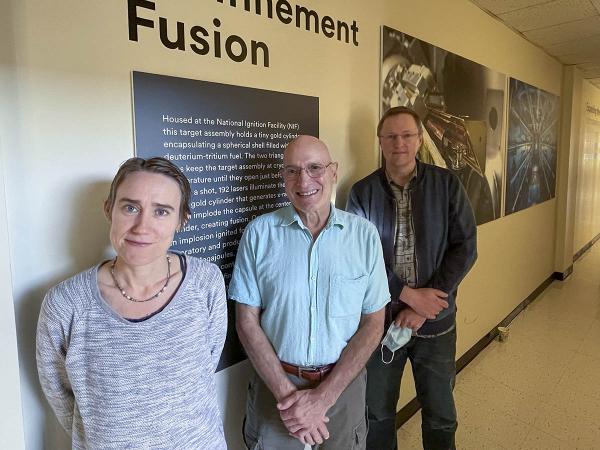
Research Scientist Maria Gatu Johnson, Senior Research Scientist Richard Petrasso, Senior Research Scientist and Division Head Johan Frenje are part of a large team selected to share the award for “the first laboratory demonstration of a burning deuterium-tritium plasma where alpha heating dominates the plasma energetics.”
Gatu Johnson, Petrasso and Frenje are part of a large team that conducted the first laboratory demonstration of a burning deuterium-tritium plasma where alpha heating dominates the plasma energetics
September 29, 2022
Three members of the Plasma Science and Fusion Center’s (PSFC) High-Energy-Density Physics (HEDP) Division have been honored with the American Physical Society’s John Dawson Award for Excellence in Plasma Physics Research. Research Scientist Maria Gatu Johnson, Senior Research Scientist Richard Petrasso, Senior Research Scientist and Division Head Johan Frenje are part of a large team selected to share the award for “the first laboratory demonstration of a burning deuterium-tritium plasma where alpha heating dominates the plasma energetics.”
Obtaining a burning plasma is a critical step towards achieving ignition and high fusion-energy gain in a laboratory. A burning plasma is one in which the fusion reactions themselves are the primary source of heating in the plasma, which is the prerequisite for sustaining and propagating the burn and achieving ignition. This was achieved at the National Ignition Facility (NIF), Lawrence Livermore National Laboratory (LLNL), and it was for this achievement the team was nominated. “This is an incredible result that represents the culmination of many decades of hard work, innovation and ingenuity, team work on a very large scale, and relentless focus on the ultimate goal,” says Frenje.
Over the past decades, the HEDP division, primarily under Richard Petrasso’s supervision, has contributed to the success of the ICF program at the NIF by providing and using a dozen diagnostics that have been essential for assessing the implosion performance and for guiding the ICF program towards the burning plasma regime and eventually ignition. One of the most important of these systems is the Magnetic Recoil neutron Spectrometer (MRS).
Maria Gatu Johnson has been the responsible scientist for the MRS since 2013 (The system was originally designed and implemented on the NIF by Johan Frenje). The spectrometer has been used extensively for more than a decade to diagnose performance of an ICF implosion through measurements of the neutron energy spectrum, from which fusion yield, plasma ion temperature, and fuel areal density (how well the fuel is spherically compressed) can be determined.
“The MRS data that Maria has provided to the program have been essential in identifying key issues with the implosions and for guiding the campaign at the NIF towards the conditions required for ignition,” says Frenje.
What makes the MRS critically important to the ignition program at the NIF is its built-in flexibility and high dynamic range, enabling it to provide high-quality data for a detailed assessment of the implosion performance for a wide range of experimental conditions. Given that the record shot produced a fusion yield substantially higher than expected, many neutron spectrometers installed on the NIF became saturated by the signal, unable to provide accurate data. Because the MRS has a high dynamic range, it was able to provide high-quality data that will be crucial to the detailed assessment of the implosion performance.
Frenje also credits the rest of the team at the PSFC’s HEDP division, the Laboratory for Laser Energetic at the University of Rochester, LLNL, and other collaborators for their support and involvement in this research, as well as the National Nuclear Security Administration of the Department of Energy (NNSA), which has funded much of their work since the early 1990s.
“Even though the three of us have been singled out, it really has been a broad effort,” says Frenje. “And very importantly one on which our students have been able to capitalize. Without the scientific dialog and know-how at the HEDP division, this would not have happened. I also want to emphasize the importance of working at PSFC, which has been a wonderful place, with great infrastructure to support this work.”